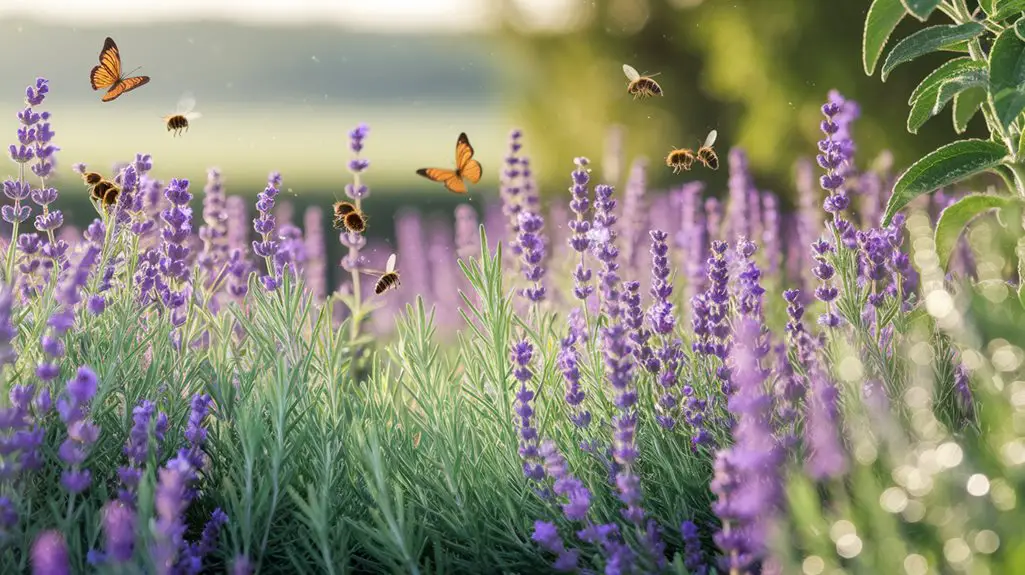Your herb garden can serve a dual purpose – providing fresh culinary ingredients while supporting essential pollinators in your ecosystem. When you combine thoughtful plant selection with strategic garden design, you'll create a vibrant habitat that buzzes with beneficial insects. Native herbs offer familiar nectar sources for local pollinators, while proper planting patterns guarantee continuous blooming throughout the growing season. Let's explore how these simple adjustments transform your herb patch into a pollinator paradise.
Choose Native Herbs That Attract Local Pollinators
When selecting herbs for your pollinator garden, native species should be your top priority as they've evolved alongside local insect populations for thousands of years. This co-evolution creates perfect matches between plant structures and pollinator feeding mechanisms.
Research which herbs are indigenous to your region—plants like bee balm, anise hyssop, and mountain mint attract diverse pollinators in eastern North America, while white sage and Cleveland sage thrive in western states. Your local extension office can provide region-specific recommendations.
Consider bloom timing when choosing natives. Select herbs that flower at different seasons to provide continuous nectar sources from spring through fall.
Early-season herbs like wild bergamot support queen bees emerging from hibernation, while late-blooming asters and goldenrod fuel monarch butterflies during migration. Additionally, incorporating beneficial insect habitats can enhance the overall health of your garden ecosystem.
Create Multi-Season Blooming Patterns in Your Herb Garden

To guarantee your pollinators have a steady food supply throughout the growing season, strategically plan your herb garden with successive blooming periods.
Start with early bloomers like chives, rosemary, and mint that flower in spring, then shift to summer-flowering herbs such as lavender, thyme, and basil.
For late summer and fall, incorporate oregano, borage, and anise hyssop.
Don't overlook longer-blooming herbs like sage and bee balm that provide extended nectar sources. Track bloom times in a garden journal to identify and fill any gaps in your flowering calendar.
Plant in clusters rather than isolated specimens—this creates visible "landing pads" that attract pollinators from greater distances.
Remember to deadhead spent flowers selectively, allowing some to develop seeds that provide additional food sources. Additionally, consider using eco-friendly practices that enhance the overall health of your garden ecosystem.
Design Herb Garden Zones With Pollinator-Friendly Features

Creating distinct zones in your herb garden serves multiple purposes for supporting pollinators throughout their life cycles. Design your garden with both sunny and partially shaded areas to accommodate different herb species and provide varied microclimates for pollinators. Additionally, incorporating pollinator-friendly plants can attract a wider variety of beneficial insects to your garden.
| Zone Type | Features | Benefits |
|---|---|---|
| Nesting Zone | Bare soil patches, hollow stems, rock piles | Provides habitat for ground-nesting bees and beneficial insects |
| Water Zone | Shallow dishes with pebbles, bird bath | Offers drinking stations without drowning risk |
| Shelter Zone | Dense herbs, small brush piles | Creates protection from predators and harsh weather |
Include pathways between zones to create "pollinator corridors" that allow safe movement throughout your garden. These thoughtfully designed zones will transform your herb garden into a multifunctional ecosystem that supports diverse pollinator needs beyond just feeding.
Conclusion
You've now joined the ranks of eco-conscious gardeners who are giving nature a helping hand. By selecting native herbs, planning for continuous blooms, and creating diverse garden zones, you're providing a sanctuary for our pollinating friends who've been facing challenging times. Your herb garden isn't just producing flavorful additions to your kitchen—it's become a crucial rest stop in the increasingly fragmented wilderness our pollinators navigate daily.




